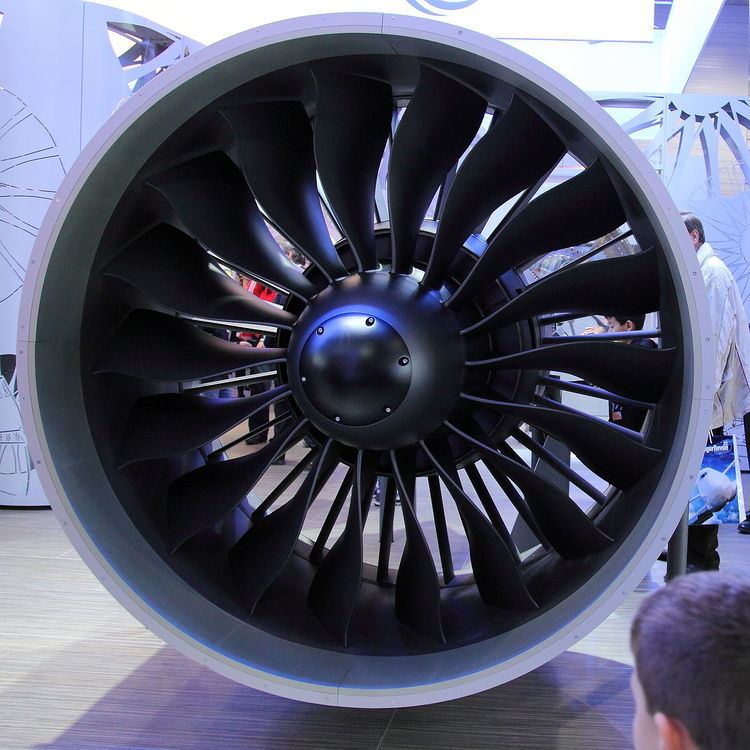 | ||
The Pratt & Whitney PW1000G is a high-bypass geared turbofan engine family, currently selected as the exclusive engine for the Bombardier CSeries, Mitsubishi Regional Jet (MRJ), and Embraer's second generation E-Jets, and as an option on the Irkut MC-21 and Airbus A320neo. The project was previously known as the Geared Turbofan (GTF), and originally the Advanced Technology Fan Integrator (ATFI). The engine is expected to deliver reductions in fuel use and ground noise when used in next-generation aircraft. The PW1000G engine first entered commercial use in January 2016 with Lufthansa's first commercial Airbus A320neo flight.
Contents
Development
Pratt & Whitney first attempted to build a geared turbofan starting around 1998, with the PW8000. This essentially was an upgrade of the existing PW6000 that replaced the fan section with a gearing system and new single-stage fan. After several years of development the PW8000 essentially disappeared.
Soon afterwards the ATFI project appeared, using a PW308 core but with a new gearbox and a single-stage fan. It had its first run on March 16, 2001. This led to the Geared Turbofan (GTF) program, which was based around a newly designed core jointly developed with German MTU Aero Engines.
In addition to the geared turbofan, the initial designs included a variable-area fan nozzle (VAFN), which allows improvements in propulsive efficiency across a range of the flight envelope. However, the VAFN has since been dropped from production designs due to high system weight.
In July 2008, the GTF was renamed PW1000G, the first in a new line of "PurePower" engines. Pratt & Whitney claims the PW1000G is 16% more fuel efficient than current engines used on regional jets and single-aisle jets, as well as being up to 75% quieter.
Flight testing
The engine was first tested on the Pratt & Whitney Boeing 747SP, then since October 14, 2008 on an Airbus A340-600 in Toulouse on the number two pylon. Testing of the CSeries bound PW1524G model began in October 2010. The PW1500G engine successfully achieved Transport Canada type certification on February 20, 2013. The A320 engine, the PW1100G, was first tested on the 747SP on 15 May 2013.
The first flight test on one of its intended production airframes, the Bombardier CS100, was on September 16, 2013. The first flight of the Airbus A320neo followed on September 25, 2014. The PW1100G engine successfully achieved FAA type certification on December 19, 2014. The fourth variant of the engine, the PW1900G, first flew on November 3, 2015 from Mirabel in Canada fitted to the Boeing 747SP test aircraft.
Introduction
The first delivery to a commercial operator, an A320neo to Lufthansa, occurred on January 20, 2016. This was instead of Qatar Airways due to rotor bow, or thermal bowing, due to asymmetrical cooling after shut-down on the previous flight. Differences in temperature across the shaft section supporting the rotor lead to different thermal deformation of the shaft material, causing the rotor axis to bend; this results in an offset between the center of gravity of the bowed rotor and the bearing axis, causing a slight imbalance and potentially reducing the tight clearance between the rotor blade tips and the compressor wall. All production standard engines now feature a damper on the third and fourth shaft bearings to help stiffen the shaft and data from engines in service and under accelerated testing is expected to gradually reduce engine start times. According to P&W President Bob Leduc, "by the time we get to June (2016), it will be down to 200 seconds for start time and by the time we get to December (2016) we will be down to 150 seconds for start time".
In an earnings briefing on 26th July the CEO of Pratt & Whitney's parent company United Technologies Gregory Hayes stated when asked about the start up issues on the PW1100G-JM; "On the technical stuff, I would tell you it is in the rearview mirror. The start time with the software drops have been pretty well addressed". Airbus group chief Tom Enders said while releasing Airbus's 2016 first half financial results that the first upgraded "golden engine" would be delivered to Lufthansa in early August 2016.
Production
At the start of its production in 2016, each GTF was costing PW $10m to build, more than the sale price, but should become less than $2m per engine. MTU provides the first four stages of the high-pressure compressor, the low-pressure turbine and other components. In October 2016, MTU started to deliver the engine assembled on its line to Airbus.
In November 2016, Pratt had fixed the issue of engine start time and wants to deliver 150 powerplants by the year-end, 50 fewer than originally planned. This is because of low yield of Fan Blades when less than one-third were passing inspection at the start of the year compared to 75% success for the latest. 350-400 engine deliveries are targeted for 2017. Fuel-burn performance is 16% better than the IAE V2500 baseline, on target, and even 18% better in best cases.
Design
By putting a 3:1 gearbox between the fan and the low-pressure spool, each spins at its optimal speed: 4,000–5,000 RPM for the fan and 12,000–15,000 RPM for the spool, the high-pressure spool spinning at more than 20,000 RPM. The 30,000 hp gearbox is designed as a lifetime item with no scheduled maintenance other than changing oil.
Applications
Specifications
Data from PW1100G Type Certificate
